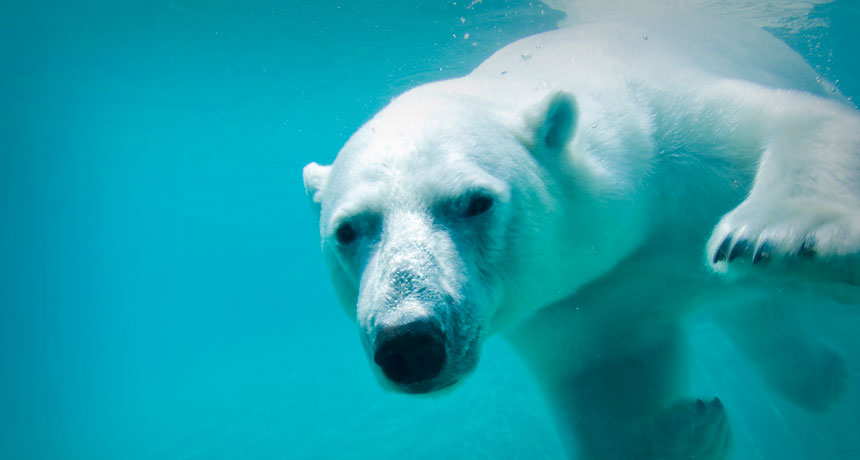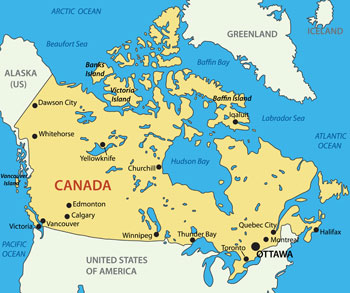Polar bears swim for days as sea ice retreats
This can tire them, causing them to lose weight and weaken

Even polar bears can get tired and lose weight if forced to swim too much. That could make it harder for them to survive.
Mike Schumann / iStockphoto
Polar bears are excellent long-distance swimmers. Some can travel for days at a time, with only very short rest stops on ice flows. But even polar bears have their limits. Now a study finds they are swimming longer distances in years with the least amount of Arctic sea ice. And that worries Arctic researchers.
Swimming a long time in cold water takes a lot of energy. Polar bears can tire and lose weight if forced to swim too much. The amount of energy they now must put into traveling in search of food could make it hard for these predators to survive.
Polar bears are swimming longer distances because of a global warming. This climate change is causing temperatures in the Arctic to warm faster than in other parts of the world. The result is more melting of sea ice and more open water.

He and his team published their new findings April 14 in the journal Ecography.
Imagine swimming for more than a week
Pilfold is an ecologist. That is a scientist who investigates how living things relate to each other and their surroundings. He was part of a team that captured 135 polar bears and put special collars on them to track how much each swam. The researchers were only interested in very long swims — those lasting 50 kilometers (31 miles) or more.
The researchers tracked the bears from 2007 to 2012. By adding data from another study, they were able to track swimming trends back to 2004. This helped the researchers see long-term trends.
In years when the sea ice melted the most, more of the bears swam 50 kilometers or more, they found. In 2012, the year in which Arctic sea ice hit a record low, 69 percent of the bears studied in the Western Arctic’s Beaufort Sea swam more than 50 kilometers at least once. That’s more than two out of every three of the bears studied there. One young female recorded a nonstop swim of 400 kilometers (249 miles). It lasted nine days. While no one can say for sure, she must have been exhausted and very hungry.
Polar bears normally spend a lot of time on ice. They rest on ice as they scout for a tasty seal. Then they can dive on top of it to make the catch.
Polar bears are very good at this. They are not so good at killing seals while swimming in open water, notes Andrew Derocher. This polar bear researcher is another of the study’s authors at the University of Alberta.
More open water means fewer opportunities for a meal. It also means swimming farther and farther to find any icy rest stop.
“Long-distance swims should be okay for adults with lots of stored body [fat],” says Pilfold. “But when you look at young or old animals, these long-distance swims can be particularly taxing. They may die or be less fit for reproduction.”
Gregory Thiemann is a polar bear expert at York University in Toronto, Canada. He points out that Pilfold’s study also shows how declining sea ice affects polar bears may depend on where they live.
Land nearly surrounds Hudson Bay, for instance, above Canada’s east-central provinces. Here, the sea ice melts completely in summer, starting from the middle of the bay. Bears can move with the ice till it melts close to shore. Then they can hop onto land.
The Beaufort Sea lies above the northern coasts of Alaska and northwestern Canada. There, the ice never melts completely; it just retreats farther from land.
“Some bears will want to get to land, perhaps to den and give birth to cubs. And those bears may have to swim a long way to get to shore,” says Thiemann. “Other bears will remain on the ice through the summer, but want to maximize their time over the continental shelf.” (A continental shelf is the shallow part of the seabed that gradually slopes out from the shores of a continent.)
Polar bears may want to hang out over the northern continental shelf because seals (the bears’ favorite meal) hang out in the shallow water there. “So those bears will tend to swim from ice floe to ice floe in an effort to both stay with the retreating ice, but spend as much time as possible where hunting is best,” explains Thiemann.
“An environment that is rapidly changing because of climate warming means that bears will likely have to spend more time in the water,” observes Thiemann. And that may be bad for these bears.
Power Words
(for more about Power Words, click here)
Arctic A region that falls within the Arctic Circle. The edge of that circle is defined as the northernmost point at which the sun is visible on the northern winter solstice and the southernmost point at which the midnight sun can be seen on the northern summer solstice.
Arctic sea ice Ice that forms from seawater and that covers all or parts of the Arctic Ocean.
Beaufort Sea This is a southern part of the Arctic Ocean, which lies north of Alaska and Canada. It spans some 476,000 square kilometers (184,000 square miles). Throughout, its average depth is about 1 kilometer (0.6 mile), although one part of it descends to almost 4.7 kilometers.
climate The weather conditions prevailing in an area in general or over a long period.
climate change Long-term, significant change in the climate of Earth. It can happen naturally or in response to human activities, including the burning of fossil fuels and clearing of forests.
continental shelf Part of the relatively shallow seabed that gradually slopes out from the shores of a continent. It ends where a steep descent begins, leading to the depths typical of most of the seafloor beneath the open ocean.
data Facts and/or statistics collected together for analysis but not necessarily organized in a way that give them meaning. For digital information (the type stored by computers), those data typically are numbers stored in a binary code, portrayed as strings of zeros and ones.
ecology A branch of biology that deals with the relations of organisms to one another and to their physical surroundings. A scientist who works in this field is called an ecologist.
empirical Based on observation and data, not on theory or supposition.
Hudson Bay An immense inland sea, meaning it has salt water and connects to the ocean (the Atlantic to the east). It spans 1,230,000 square kilometers (475,000 square miles) within east-central Canada, where it is nearly surrounded by land in Nunavut, Manitoba, Ontario and Quebec. Much of this relatively shallow sea lies south of the Arctic Circle, so its surface remains ice-free from roughly mid-July to October.
predator (adjective: predatory) A creature that preys on other animals for most or all of its food.







